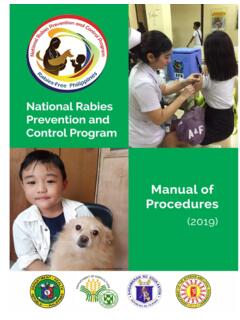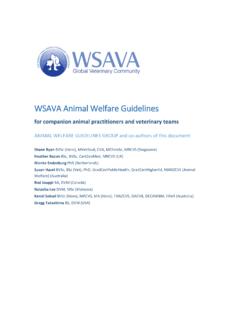Transcription of Part 1 Biosecurity principles and components
1 Part 1 Biosecurity principles and components3 Introduction3 What is Biosecurity ?3 The context of modern biosecurity4 Who is involved?6 Rationale for a harmonized and integrated approach to biosecurity6 Biosecurity linkages6 Risk analysis7 Primary drivers for change9 Biosecurity in a modern world9 What constitutes a Biosecurity hazard?9 Sector changes in biosecurity14 Harmonization and integration of approaches tobiosecurity14 Changing approaches to biosecurity15 Requirements for a harmonized and integrated approach to biosecurity17 Enhancing specific aspects of Biosecurity through a harmonized and integratedapproach20 ConclusionsWHAT IS Biosecurity ? Biosecurity is a strategic and integrated approach thatencompasses the policy and regulatory frameworks(including instruments and activities) for analysing andmanaging relevant risks to human, animal and plant lifeand health , and associated risks to the covers food safety, zoonoses, theintroduction of animal and plant diseases and pests,the introduction and release of living modifiedorganisms (LMOs) and their products ( geneticallymodified organisms or GMOs), and the introductionand management of invasive alien species.
2 Thusbiosecurity is a holistic concept of direct relevance tothe sustainability of agriculture, and wide-rangingaspects of public health and protection of theenvironment, including biological diversity. The overarching goal of Biosecurity is to prevent,control and/or manage risks to life and health asappropriate to the particular Biosecurity sector (Figure ). In doing so, Biosecurity is an essentialelement of sustainable agricultural development. This toolkit advocates a strategic and integratedapproach to Biosecurity as a holistic concept that is ofdirect relevance in meeting consumer expectations inrelation to the safety of their food supply, preventingand controlling zoonotic aspects of public health ,ensuring the sustainability of agriculture, safeguardingterrestrial, freshwater and marine environments, andprotecting biodiversity. Biosecurity may also includemeasures to ensure security of the food supply interms of counter-terrorism.
3 Terms related to biosecuritythat are used in this toolkit are included in the glossaryin Annex 1. THE CONTEXT OF MODERN BIOSECURITYB iosecurity issues have an ever-increasing profile on aglobal basis due to a range of factors (Box ). Theincreasing diversity and volume of international trade inanimals, plants and their products is a key contributorin the spread of recognized diseases from region toregion. Changing agricultural practices are resulting innew hazards to health that are readily able to crossborders. Changing human ecology and behaviour alsocontribute to the greater incidence and spread ofhazards of public, animal and plant health technologies add a further dimension, for instanceorganisms and products derived from biotechnologyneed to be evaluated for any potential risks to and components IntroductionFigure Sector goals of biosecurityHuman life and health (including food safety) Animal life and health (including fish)Plant lifeand health (including forests)
4 Environmental protection Globalization New agricultural production and food processingtechnologies Increased trade in food and agricultural products Legal obligations for signatories of relevant internationalagreements Increasing travel and movement of people acrossborders Advances in communications and global access tobiosecurity information Greater public attention to biodiversity, the environmentand the impact of agriculture on both Shift from country independence to countryinterdependence for effective Biosecurity Scarcity of technical and operational resources High dependence of some countries on food imports Box factors influencingbiosecurityWith increasing public awareness of the impact ofadverse Biosecurity events and interventions, politicaland social demands on government regulatoryagencies are resulting in considerable infrastructuralchange. Stakeholder interest is fuelled by technologicaladvances in detection and management of hazards tolife and health , together with the often unresolvedscientific debate that surrounds the potential of verylow levels of hazards to result in adverse health orenvironmental IS INVOLVED?
5 National stakeholdersBiosecurity involves many different kinds ofstakeholders at the national level. Governmentagencies have a primary interest but industry, scientificresearch institutes, specialist interest groups, non-governmental organizations (NGOs) and the generalpublic all have a vital role to play. Several branches of government, at both thenational and sub-national levels, are involved. The competent authorities responsible for thesectors usually associated with Biosecurity foodsafety, public health , agriculture, forestry, fisheries andthe environment play the primary role in acontemporary integrated approach to , other parts of government responsible forsectors such as trade, customs, transport, finance andtourism can also play a role depending on nationalcircumstances (see Figure and Annex 2). Inaddition, third party organizations are oftencontracted by competent authorities to deliver a rangeof core Biosecurity functions including surveillanceprogrammes, incursion response activities andlaboratory diagnostic services.
6 International stakeholders At the global level, international standard-settingorganizations, international bodies and international4fao Biosecurity toolkit | part 1 Figure interests that are important to an integrated approach to Biosecurity IntegratedBiosecurityApproachOther governmentactivities ( trade,customs, tourism, marine conservation)Competent authorities foragriculture, forestry,fisheries, food safety and public health Public opinion and representationIndustry (including importers and exporters)Primary producers of food and agriculturalcommodities ( farmers, fishers)NGOs, special interest groups, the mediaScientific researchinstitutes anduniversitieslegal instruments and agreements play important andcomplementary roles in Biosecurity . International standard-setting organizations andbodies like the Codex Alimentarius Commission (CAC),the World Organisation for Animal health (OIE) and theCommission on Phytosanitary Measures (CPM)5develop standards6for different Biosecurity sectors inaccordance with their mandates.
7 While internationalstandards are not legally binding in and of themselves,they have become international reference pointsthrough the World Trade Organization (WTO)Agreement on the Application of Sanitary andPhytosanitary Measures (SPS Agreement), whichadopted them in 1995 as the benchmark for allinternational sanitary and phytosanitary measures. Responsibilities for sectors of Biosecurity at theinternational level are shared among a number oforganizations and bodies. Reflecting its mandate andcompetencies, FAO plays a leading role in normativework and technical assistance, at the both the nationaland international levels, to support the implementationof a Biosecurity approach. Related activities includethe organization of expert and technical consultationson Biosecurity , the development of tools to assistcountries to apply a Biosecurity approach and supportcapacity building, and the development and operationof the International Portal on Food Safety, Animal andPlant Health7to facilitate the exchange of relevantinformation.
8 FAO hosts the Secretariat for the CodexAlimentarius Commission, under the Joint FAO/WHOFood Standards Programme, as well as the Secretariatfor the International Plant Protection Convention(IPPC). In addition, FAO s participation in theStandards and Trade Development Facility (STDF)aims to enhance collaboration between the three SPS-recognized standard-setting bodies and FAO, the World Bank, the World health Organization (WHO)and WTO. WHO supports countries to prevent, detect, verifyrapidly and respond appropriately to epidemic-proneand emerging disease threats when they arise tominimize their impact on the health and economy ofthe world s population. This includes prevention, alertand response operations, laboratory andepidemiological strengthening, preparedness fordeliberate epidemics, support for the Global OutbreakAlert and Response Network, and the revisedInternational health Regulations, referred to as IHR(2005).8 Under IHR (2005), WHO has the mandate tocollaborate with States Parties to evaluate their publichealth capacities, facilitate technical cooperation,logistical support and the mobilization of financialresources for building capacity in prevention,surveillance and addition to the standards and related textsdeveloped by the CAC, the OIE and the CPM, severalother international legal instruments, agreements andtexts are relevant to Biosecurity .
9 These include the SPSA greement and, to some extent, the Agreement onTechnical Barriers to Trade (TBT Agreement), theConvention on Biological Diversity (CBD) and itsCartagena Protocol on Biosafety9, and the InternationalHealth Regulations. These generally have a single sectorperspective ( food safety, human/animal/plant health ,protection of the environment, biosafety, biologicaldiversity, nature conservation, wetland protection,marine resources). However, they share certain commoncharacteristics including risk analysis principles ,notification procedures and information legal instruments, agreements, texts,organizations and bodies associated with Biosecurity arelisted in Annex and components Introduction5 The Commission on Phytosanitary Measures (CPM) governs theIPPC (an international treaty to secure action to prevent the spread andintroduction of pests of plants and plant products, and to promoteappropriate measures for their control) and adopts InternationalStandards for Phytosanitary Measures (ISPMs).
10 6 For the purposes of this toolkit, use of the word standard as anoutput of international standard-setting organizations and bodies istaken to include standards, guidelines and other recommendations .It is noteworthy that the WTO considers that the SPS Agreement doesnot differentiate between these terms and they would each be appliedaccording to their substantive content rather than their category. JointFAO/WHO Food Standards Programme. CAC. Report of the 23rdSession. Rome, 28 June to 3 July 1999. ALINORM 99/33 (available at: ). 7 Available at: revision of the International health Regulations was unanimouslyadopted on 23 May 2005 by the World health Assembly and theseRegulations entered into force in June 2007. See Annex 3 for is defined as: Means to regulate, manage or control therisks associated with the use and release of living modified organismsresulting from biotechnology which are likely to have adverseenvironmental impacts that could affect the conservation andsustainable use of biological diversity, taking also into account therisks to human health .















